Power Shift - Allston's Green District
Air Date: Week of September 28, 2012
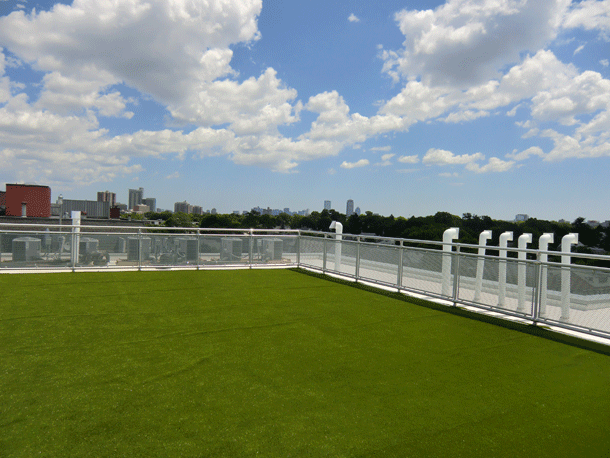
Rooftop lawn of The Element. (Photo: The Mount Vernon Company)
In a bid to make green living economically viable and attractive, an ambitious new community is springing up in Boston. Reporter Bruce Gellerman checks it out.
Transcript
CURWOOD: It's Living on Earth, I'm Steve Curwood.
[SFX: SUBWAY]
CURWOOD: Next stop: the Allston Green District. It's the scene of a large-scale environmental and economic experiment in urban living, just 4 miles from downtown Boston, and designed to meet the city’s energy efficiency guidelines for new construction. Bruce Gellerman has our report.
GELLERMAN: Allston is a neighborhood of decaying industrial buildings, storefronts, and off-campus student housing. Here, the Green Line subway runs above ground down the middle of Commonweath Avenue - past a world array of ethnic restaurants, bars, and clubs. And just one block off Comm Ave…
[SFX: SCRAPING BRICKS]
GELLERMAN: Workers are putting the finishing touches to the first of 7 buildings —each unique — that together promise to transform this neighborhood. A mason scrapes the extra cement from a newly laid brick wall...
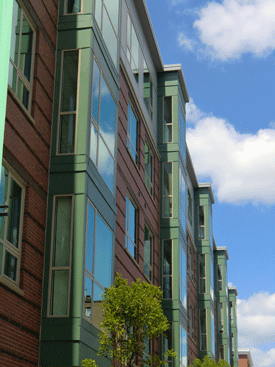
The front of The Element (Photo: Bruce Gellerman)
[SFX: SAW]
GELLERMAN: ...and sheet metal worker Shane Meredith cuts the final pieces for a work of art that doubles as a first floor window grate.
MEREDITH: Usually they have straight bars on them. It almost looks like a prison, but something like this… it’s strong enough, it can keep people out, and it's very pleasing to the eye. The more fancy you get the more money it costs - yeah, definitely. It’s supposed to represent grass blowing.
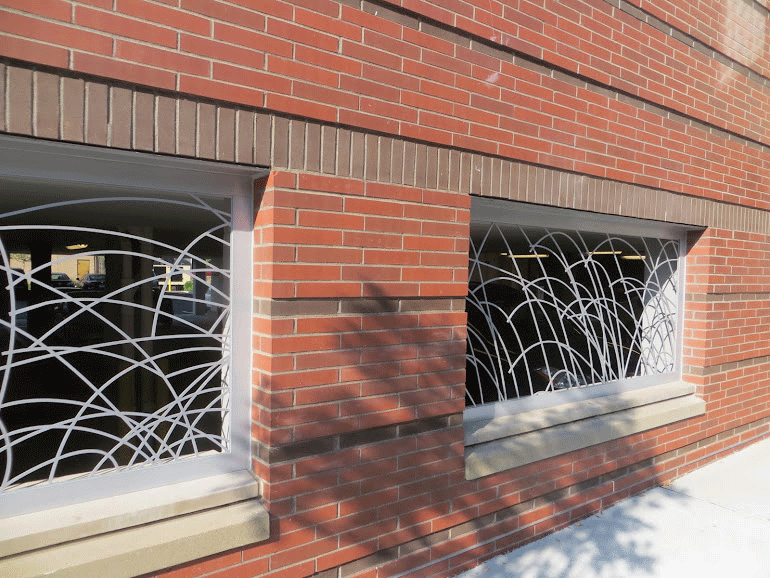
The public art work city grass doubles as a window grate. (Photo: Bruce Gellerman)
GELLERMAN: The window grate sculpture is called City Grass – functional urban art designed by inner city kids. City Grass is the logo for The Element, the first building in an ambitious 125 million dollar project. When it's all done it'll be a 500 apartment community filled with state of the art environmentally friendly features. And says developer Bruce Perceley, lots of art – much of it made from recycled materials.
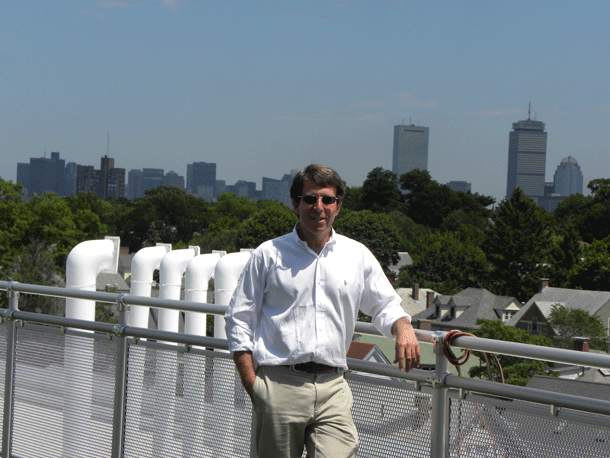
Bruce Percelay is CEO and Founder of Mount Vernon Company on top of The Element. (Photo: The Mount Vernon Company)
PERCELEY: What we have done is designated areas throughout this whole neighborhood for public art. And we feel public art humanizes a neighborhood. This building is a blank canvas that allowed us to apply all our creativity to it and when you go throughout the building you're gonna see that virtually every square inch has some idea that we have pulled out of thin air and applied.
GELLERMAN: Let’s go.
[SFX: WALKING OUTSIDE AND ENTERING THE BUILDING FROM STREET]
GELLERMAN: The lobby of The Element will be heated with a high efficiency gas fireplace. All the walls are super-insulated. The windows are floor to ceiling- triple pane, allowing sunlight in, keeping street noise out, and indoor temperatures constant. Little things add up.
PERCELEY: To encourage bicycle use we have bike racks throughout the entire garage and we have interior bike storage. So this building is extremely bicycle friendly.

The green district offers a rental bike rack and the Boston subway 1 block away. (Photo: Bruce Gellerman)
GELLERMAN: You can rent a bike on-site, or charge your electric car. And in the basement, toss your trash into a high-tech single stream, centralized sorter. On one building there'll be solar panels, on another maybe a wind turbine. That's if Boston officials allow it - so far, they haven’t - wind turbines aren't efficient enough.
[SFX: DOOR UNLOCKING]
GELLERMAN: In 2007 Boston became the first city in the nation to adopt green building regulations. The regs require large-scale developers to dramatically reduce climate changing emissions from their buildings and adhere to the US Green Building Council’s LEED certification standards.
PERCELEY: This may be the first rental property, green designated community, in the east coast, and we have created a comprehensive green environment that will provide a new standard of green living for rental properties perhaps anywhere.
GELLERMAN: As CEO of The Mount Vernon Company, one of Boston's largest real estate firms, Bruce Perceley is a persuasive salesman. He’s always pitching. He got city officials to designate his seven building community the Allston Green District – that's also the new name for the subway stop just down the block. But selling residents on going green takes more than just offering energy efficient features and appliances. It’s called for carrots – luxury amenities – and sticks – strict rules for green living. First: some carrots.
[SFX: BEEPING]
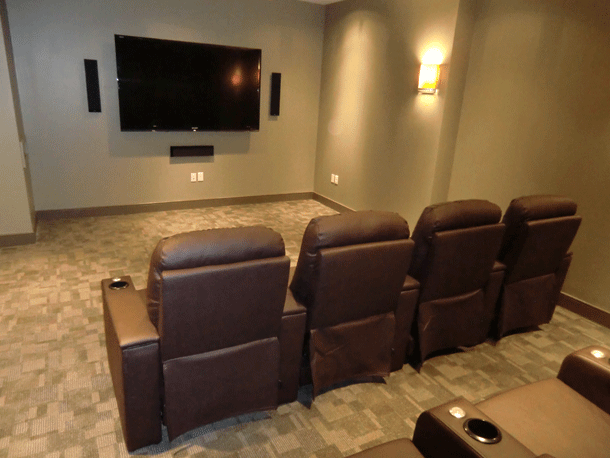
The screening room is one of the eco luxury amenities. (Photo: Mount Vernon Company)
PERCELEY: We’re going to take you to the movie theater and the common room and what the movie theater tells you is that green living doesn’t necessarily mean spartan living.
This is a club room with a full kitchen and it will have furniture so it will double as a lounge. Every few weeks we are going to provide cooking classes for our tenants. This is a population that's generally between the age of 25 and 35 and doesn’t always eat right, so we’re gonna provide then with an education on how to cook for themselves in a healthy way. And we are very curious to see what kind of turnout we're gonna get but I suspect this will be a popular feature of this building.
GELLERMAN: Then there’s the amenity born of one of Bruce Perceley's pet peeves - literally a pet peeve. PET is the plastic found in many single-use water bottles.
PERCELEY: This is a hydration station, and you’ll be able to take a high quality re-useable sports bottle, and you put it up to the nozzle against the wall, and you receive reverse osmosis thoroughly, totally purified water. Because I personally object to the ridiculous waste of plastic bottles that take forever to decompose.
GELLERMAN: So do they have to pay extra for this or is it standard issue part of the rent?
PERCELEY: The hydration station and many other features in this building are included in the rent.
GELLERMAN: So what does it cost to live here?
PERCELEY: Rents start at 1700 dollars and they go as high as 2800 dollars. Now, comparatively, for living of this quality in downtown Boston this is about half the price.
[SFX: ELEVATOR]
GELLERMAN: Ok, so now where are we going?
PERCELEY: Right now we’re going to go to the roof deck. And this is a feature of this building that is quite remarkable in that even though this is a building in Allston it probably is the nicest roof deck in the city of Boston.
GELLERMAN: Oh this I gotta see…(LAUGHS) It's like a putting green. It’s like a golf course here!
PERCELEY: We have 2800 square feet of recycled artificial turf that to the foot feels like real grass. This is not short Astroturf — it bends like grass does. And then along the back of this we will have set up planters that will serve as organic roof gardens. We will have ipod stations and we have speakers so you can relax and listen to music.
GELLERMAN: And you've got a million dollar view of the skyline of Boston.
PERCELEY: At early evening that view is magical.
GELLERMAN: So the Allston Green District offers a lot of carrots, but there is one big stick. Bruce Perceley calls it a green declaration all tenants will have to sign before they can move in.
PERCELEY: And that green declaration asks the tenants to cooperate with us in making this building the most environmentally sensitive building anywhere. Some of the aspects of the green declaration are institutionalized into the building. For example, we are the first landlord in Boston to separately meter for water. When water use is paid for by the tenant it reduces consumption by 40 percent. So therefore we’ve given them a little bit of a prod because it will hit them in the pocketbook. So water conservation will happen by itself.
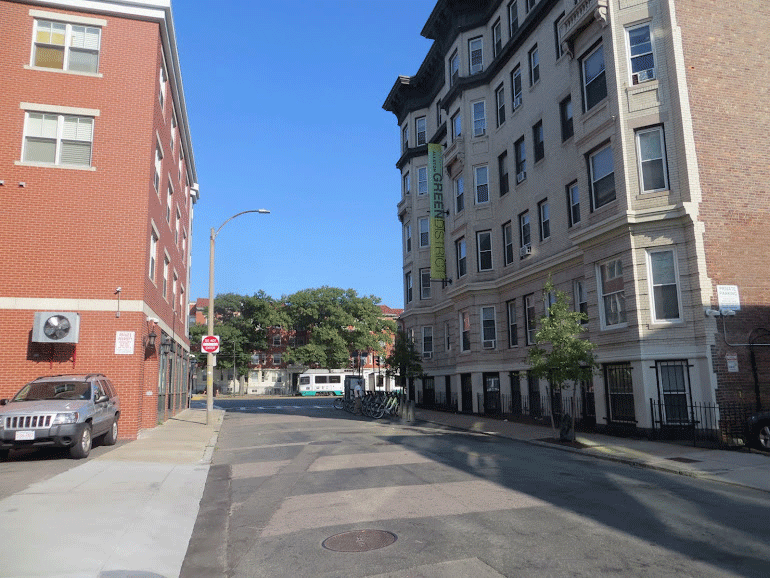
Building one in the Green District is ready for occupancy. (Photo: Bruce Gellerman)
GELLERMAN: So shorter showers?
PERCELEY: Shorter showers, perhaps when they go to use their dishwasher it will be full instead of half full, they will do their laundry more efficiently, and they will be more mindful of how they use water.
GELLERMAN: Well, how do you reinforce that? I mean, do you have the green police knock on their door one night in the middle of the night saying, 'Hey, come out with your hands up, you've been using too much water?'
PERCELEY: The best reinforcement is the fact that they are paying for it. The wallet is the reinforcer.
GELLERMAN: When somebody comes to you and they say, 'You know, this is a really interesting idea. I'm interested.' Do you interview them to make sure that they are your type of tenant?
PERCELEY: That's a very fine line...
GELLERMAN: You're not green enough for me?
PERCELEY: Yeah, we're doing it the other way around. We’re promoting this as a green community and we're hoping green people show up.
GELLERMAN: One of the first green people to show up and sign a lease at the Allston Green District was 20-something Kimberly Lauber. Her dad was carrying boxes off the elevator, helping her to move into her new eco-apartment.
LAUBER: I really like the idea of an eco-friendly area and that they’re using eco-friendly materials to build the building, especially the floors – I really liked that. I like the spaces, we like the really big windows. And they said a lot of young professionals were living in the building which was also nice so we thought that it would be a nice place for us to get our first apartment actually.
GELLERMAN: What about the green declaration? You had to sign a declaration; did that bother you at all?
LAUBER: I mean, no. I mean, it was one of those things that came additionally later but I thought it was a good contribution to earth and to be green and to contribute to the community, make it better.
PERCELEY: We really do want this to become the beginning of something big.
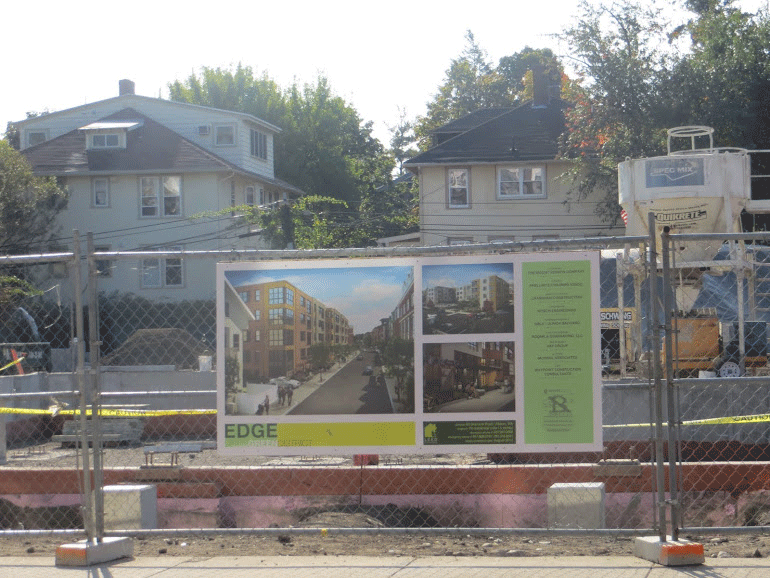
Work has already begun on building two, The Edge , in the green district project. (Photo: Bruce Gellerman)
GELLERMAN: Developer Bruce Perceley says his big idea goes beyond renewable energy, retrofitting or recycling. It’s about human values, social environments, and sustaining a community.
PERCELEY: That’s a very important point. We are trying to create an environment that encourages interaction. People often come to these apartment buildings and they only get to know each other if there is a fire drill or a power outage and they all get together. We want to make this a place where people get to know each other and to create a true sense of community within the building.
[SFX: SUBWAY BELLS]
GELLERMAN: So green start to finish. How about green - your bottom line? Can you make money doing this?
PERCELEY: That’s a very interesting question. Green does have costs associated with it. That said it is our long-term belief that it will enable us to attract a better tenant,
It will enable us to retain the tenants longer, and the ultimate testimony to that is we preleased 100 percent of a hundred unit building before it was completed. That is virtually unheard-of. If that doesn’t say that green works I don’t know what does.
GELLERMAN: Bruce Perceley, CEO of the Mount Vernon Company and developer of The Allston Green District. For Living on Earth, I’m Bruce Gellerman in Allston, Massachusetts.
Links
Living on Earth wants to hear from you!
Living on Earth
62 Calef Highway, Suite 212
Lee, NH 03861
Telephone: 617-287-4121
E-mail: comments@loe.org
Newsletter [Click here]
Donate to Living on Earth!
Living on Earth is an independent media program and relies entirely on contributions from listeners and institutions supporting public service. Please donate now to preserve an independent environmental voice.
NewsletterLiving on Earth offers a weekly delivery of the show's rundown to your mailbox. Sign up for our newsletter today!
 Sailors For The Sea: Be the change you want to sea.
Sailors For The Sea: Be the change you want to sea.
 The Grantham Foundation for the Protection of the Environment: Committed to protecting and improving the health of the global environment.
The Grantham Foundation for the Protection of the Environment: Committed to protecting and improving the health of the global environment.
 Contribute to Living on Earth and receive, as our gift to you, an archival print of one of Mark Seth Lender's extraordinary wildlife photographs. Follow the link to see Mark's current collection of photographs.
Contribute to Living on Earth and receive, as our gift to you, an archival print of one of Mark Seth Lender's extraordinary wildlife photographs. Follow the link to see Mark's current collection of photographs.
 Buy a signed copy of Mark Seth Lender's book Smeagull the Seagull & support Living on Earth
Buy a signed copy of Mark Seth Lender's book Smeagull the Seagull & support Living on Earth

